If you’re looking to bring a tropical touch to your home garden, Dipladenia planting is a perfect choice. With its glossy green leaves and trumpet-shaped flowers in vibrant shades of red, pink, white, and yellow, Dipladenia instantly brightens any space. Gardeners around the world love this plant because it combines exotic beauty with easy care—it blooms for months, adapts well to both outdoor beds and containers, and requires far less maintenance than many other tropical plants. Whether on a balcony, patio, or garden border, Dipladenia offers long-lasting color and charm, making it one of the most popular tropical flowering plants worldwide.
What is Dipladenia?
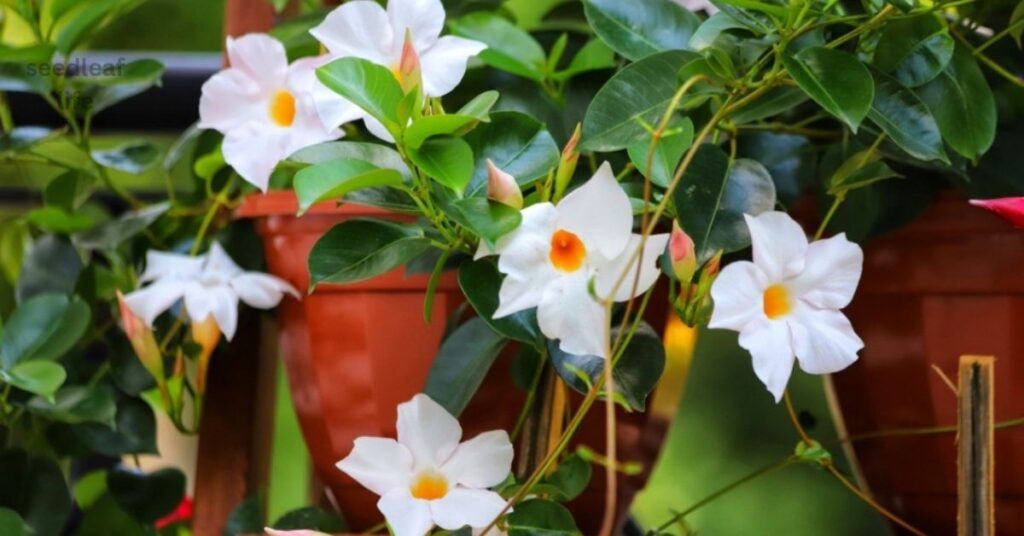
Dipladenia is a tropical flowering plant that instantly adds charm to any garden. It’s actually a close cousin of the famous Mandevilla, but unlike its climbing relative, Dipladenia has a more compact, bushy shape. This makes it a great option if you don’t have much space but still want a burst of tropical beauty. With its shiny green leaves and trumpet-shaped flowers, it’s the kind of plant that never fails to catch attention.
Origin and Background
Dipladenia comes from the warm, tropical regions of South America. Being native to this climate, it loves sunshine, warmth, and a little humidity. Over the years, it has traveled far beyond its homeland, winning the hearts of gardeners across the world for its ability to adapt to different environments—whether planted outdoors in the ground or in containers on balconies.
Key Characteristics
What makes Dipladenia stand out? A few things:
- Bushy Growth – Unlike climbing vines, Dipladenia grows neatly, making it easier to manage.
- Glossy Leaves – The deep green foliage adds richness, even when the plant isn’t flowering.
- Trumpet Flowers – Available in reds, pinks, whites, and yellows, these blooms attract butterflies and hummingbirds.
- Long Blooming Season – Flowers can appear from spring right into late fall, filling your garden with color.
Dipladenia vs. Mandevilla
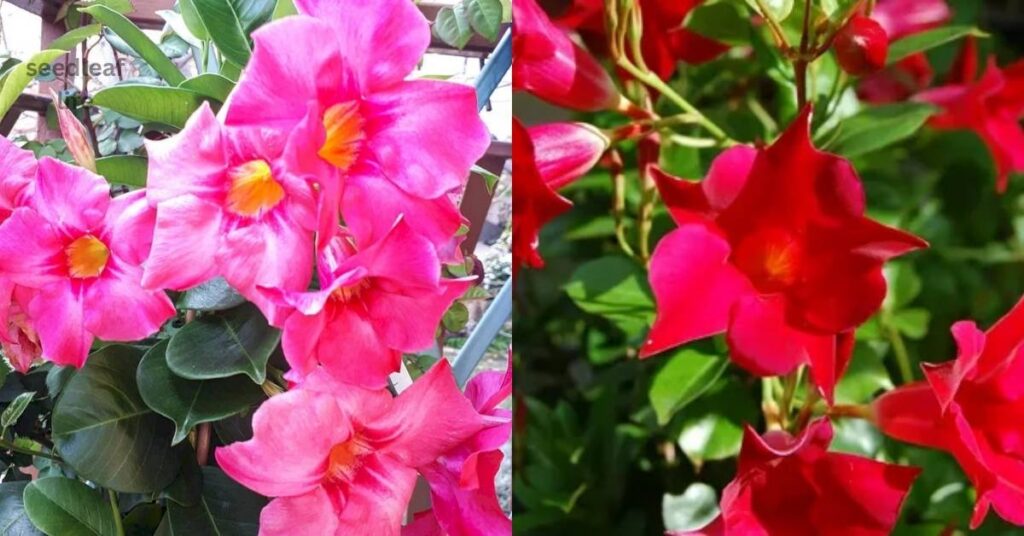
Many people confuse Dipladenia with Mandevilla, and it’s easy to see why—they’re closely related. For a detailed comparison, check out this guide on PegPlant. The main difference is in how they grow:
- Mandevilla is a vigorous climber, great if you want a plant to cover a trellis or fence.
- Dipladenia, on the other hand, stays compact and bushy, making it ideal for pots, patios, and smaller gardens.
So, if you want a bold, climbing statement, go for Mandevilla. But if you prefer a neat, container-friendly tropical plant, Dipladenia is the perfect match.
Why Choose Outdoor Dipladenia Planting
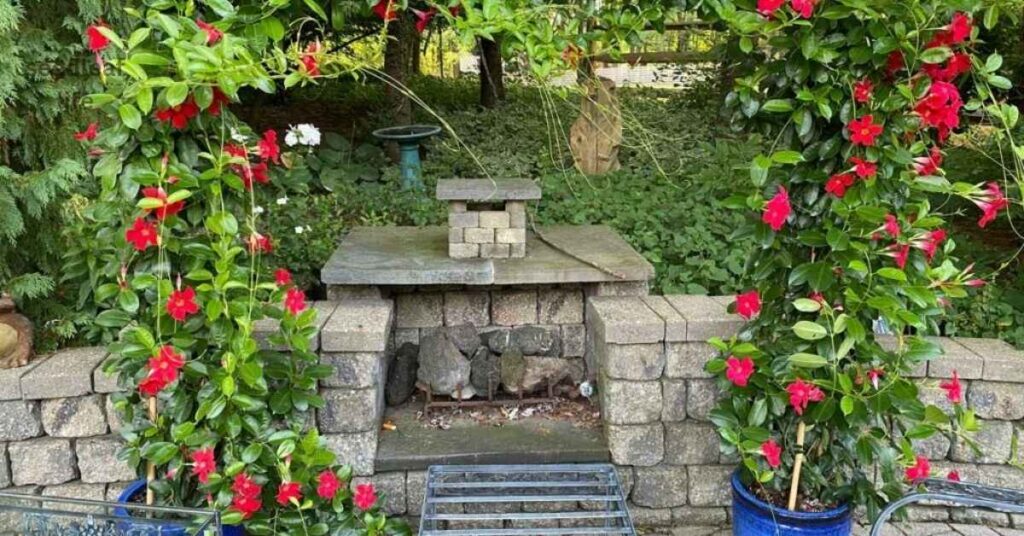
When it comes to creating a colorful and lively garden, Dipladenia planting is one of the best choices you can make. This tropical beauty isn’t just about looks—it’s a plant that offers both charm and practicality. Whether you want to brighten up a backyard, decorate a small balcony, or attract pollinators, Dipladenia delivers all of it with very little effort.
Benefits in Gardens and Landscapes
- Long-lasting blooms – Dipladenia flowers from spring into late fall, keeping your garden vibrant for months.
- Easy to grow – Unlike many tropical plants, it doesn’t demand constant care.
- Compact size – Perfect for flower beds, borders, and mixing with other plants.
- Low water needs – Once established, it tolerates dry spells better than most flowering plants.
Adding Dipladenia to your garden gives you a burst of tropical color without the stress of high maintenance.
Dipladenia as a Pollinator-Friendly Plant
One more reason to love Dipladenia planting is its ability to attract pollinators. Its bright, trumpet-shaped flowers act like magnets for hummingbirds, butterflies, and bees. Not only does this add life and movement to your garden, but it also helps pollinate other plants nearby. A garden filled with Dipladenia is not just beautiful—it’s also buzzing with activity.
Dipladenia Varieties
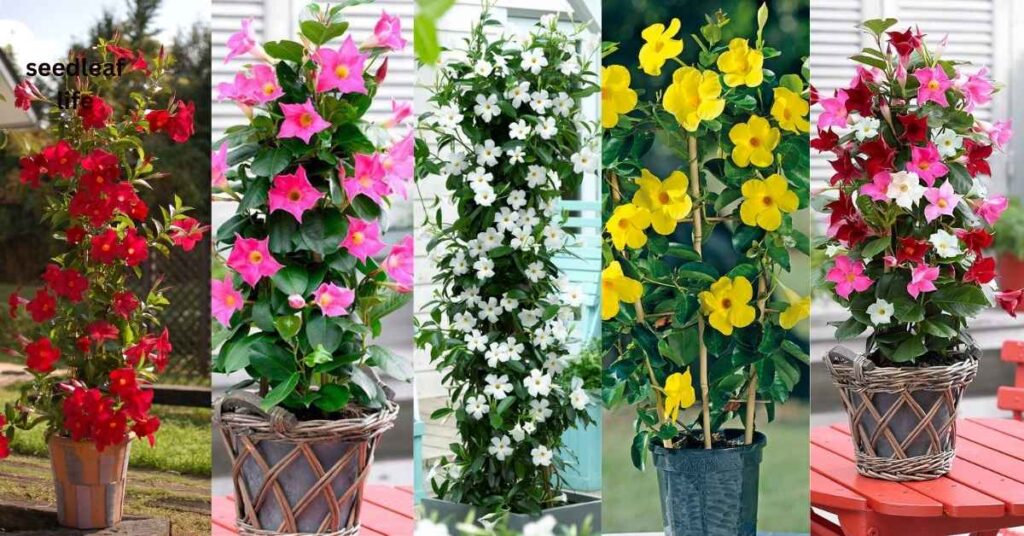
One of the most exciting parts of Dipladenia planting is choosing from its wide range of colorful varieties. Each one brings its own personality to the garden, so whether you love bold reds or soft pastels, there’s a Dipladenia for you. For more vibrant options, check out yellow flowering plants that can complement your garden.
Let’s take a look at the most popular types::
Dipladenia Red
The classic and probably the most eye-catching variety. Its deep, velvety red blooms instantly create a dramatic focal point in any garden. Perfect for bold gardeners who want a strong splash of color in flower beds or patio pots.
Dipladenia Pink
A softer, romantic option that ranges from light pastel pink to rich, vibrant shades. Dipladenia Pink is a favorite for balconies and patios where a gentle, welcoming look is desired. Pairing it with white or yellow flowers creates a stunning contrast.
Dipladenia White
Elegant and timeless, Dipladenia White brings a fresh, clean vibe to gardens. The pure white blooms stand out beautifully against the plant’s glossy green leaves, making it a great choice for evening gardens or minimalist outdoor designs.
Dipladenia Yellow
A rarer variety, but truly special. Dipladenia Yellow adds warmth and cheer wherever it’s planted. Its sunny flowers brighten shaded patios and blend beautifully with other tropical plants for a vibrant display.
Hybrid Dipladenias
Thanks to modern breeding, many hybrid Dipladenias are now available. These hybrids often bloom longer, resist pests and diseases better, and come in unique color blends. They’re perfect if you want low-maintenance plants with an extra punch of color and resilience.
Dipladenia Sunlight Requirements
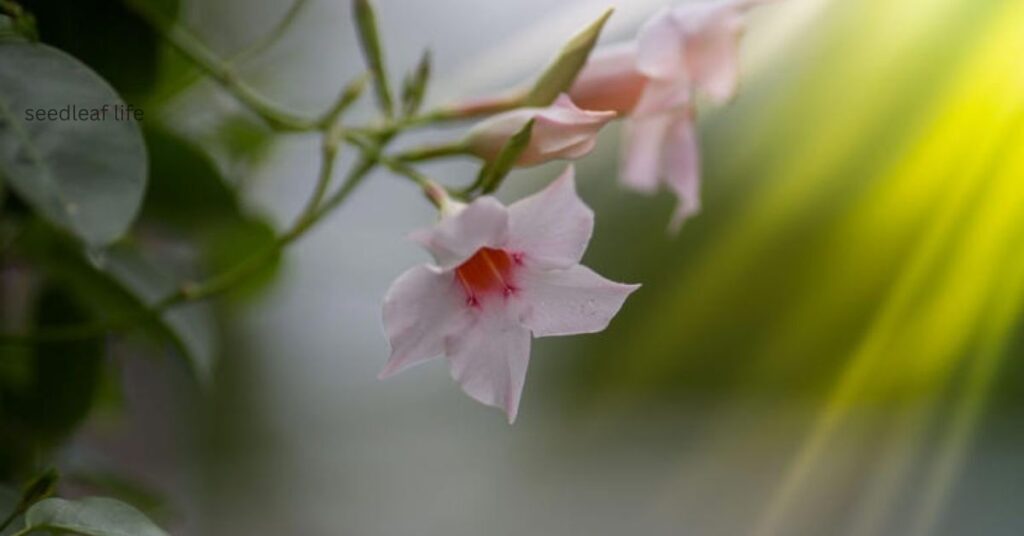
Sunlight is one of the most important factors in successful Dipladenia planting. Since this plant originates from tropical South America, it naturally thrives in warm, bright environments. Giving it the right balance of sun ensures healthy leaves, strong roots, and plenty of blooms.
Full Sun vs. Partial Shade
- Full Sun: Ideally, Dipladenia should receive 6–8 hours of direct sunlight daily. This encourages maximum flowering and strong growth. If you want vibrant, nonstop blooms, full sun is the best option.
- Partial Shade: In very hot regions, especially during peak summer afternoons, a little shade can protect the plant from leaf scorch. Morning sunlight with light afternoon shade is often the perfect balance in such climates.
If you live in cooler areas, prioritize maximum sun exposure, as Dipladenia will struggle to bloom in shady conditions.
Indoor Placement Tips
Not everyone can grow Dipladenia outdoors year-round. For container gardeners who bring plants indoors during winter:
- Place Dipladenia near a south-facing window where it gets bright, direct light.
- If natural sunlight is limited, consider using a grow light to keep the plant healthy.
- Rotate pots every week to ensure even growth and prevent the plant from leaning toward the light source.
Signs of Too Much or Too Little Sun
Plants often “talk” through their leaves and flowers, and Dipladenia is no exception. Watch for these signs:
- Too Much Sun: Leaves may look scorched, turn yellow-brown, or curl at the edges. Flowers may fade quickly.
- Too Little Sun: Fewer blooms, leggy stems, and pale leaves are clear indicators the plant isn’t getting enough light.
Balancing light exposure is key. With proper sunlight, Dipladenia planting rewards you with a long season of lush greenery and colorful flowers.
Dipladenia Soil Type
Healthy soil is the secret behind successful Dipladenia planting. While this tropical plant isn’t overly demanding, it does best when the soil meets a few simple conditions. The right foundation ensures steady growth, vibrant leaves, and flowers that keep blooming for months.
Ideal Soil Conditions
Dipladenia loves soil that drains well yet holds enough moisture to keep roots hydrated. The perfect mix is:
- Light and airy texture to prevent root rot.
- Slightly acidic pH (around 6.0–6.5).
- Nutrient-rich base so the plant gets steady nutrition.
If the soil is too heavy or clay-like, roots can suffocate, which often leads to yellowing leaves or stunted growth.
Soil Amendments for Better Growth
Not everyone has perfect garden soil—but that’s easy to fix. To improve poor soil:
- Mix in compost or organic matter for added nutrients.
- Add sand or perlite to boost drainage.
- Use a layer of mulch on top to lock in moisture and keep roots cool.
These small tweaks can transform average soil into the ideal growing medium for your plant.
Container Soil Mix for Dipladenia
If you’re growing Dipladenia in pots or hanging baskets, the soil mix becomes even more important. A good container mix should be:
- Lightweight to let water drain easily.
- Enriched with peat moss or coconut coir to hold just enough moisture.
- Blended with perlite or vermiculite for airflow around the roots.
A high-quality potting mix designed for flowering plants usually works perfectly. With the right container soil, Dipladenia planting becomes almost effortless, and your plant will reward you with stronger growth and a longer bloom cycle.
How to Do Dipladenia Planting Step by Step
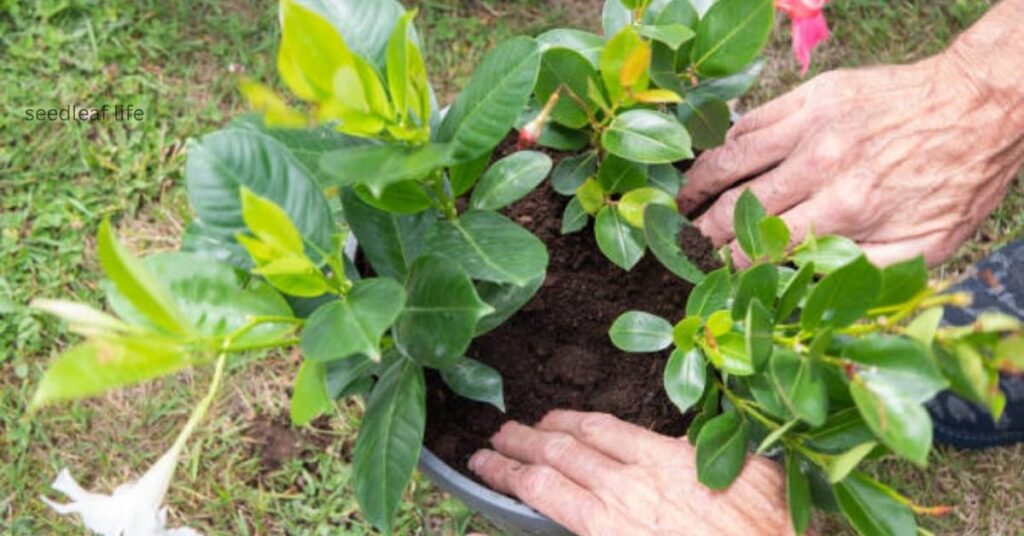
Whether you’re planning a colorful flower bed or a stylish patio display, Dipladenia planting is simple once you know the basics. Here’s a step-by-step guide to help you get started.
Garden Planting Method
- Choose the right spot – Pick a sunny location that gets at least 6 hours of direct sunlight.
- Prepare the soil – Loosen the ground and mix in compost or organic matter to enrich it.
- Dig the hole – Make a hole twice the width of the root ball but only as deep as the plant’s roots.
- Plant carefully – Place the Dipladenia in the hole, ensuring the crown sits level with the soil surface.
- Backfill and firm – Cover the roots with soil, gently pressing down to remove air pockets.
- Water deeply – Give the plant a thorough watering to help it settle.
- Mulch the base – Add a layer of mulch to keep the soil moist and cool.
This method helps your plant establish strong roots for long-term growth.
Outdoor Container Gardening Dipladenia
Growing in containers is one of the easiest ways to enjoy Dipladenia planting, especially if you have limited garden space.
- Pick a pot with drainage holes to prevent soggy roots.
- Use lightweight potting mix enriched with perlite or sand for better airflow.
- Plant at the center of the container, leaving space at the top for watering.
- Water until it drains out of the bottom, then place the pot in a sunny spot.
- For patios or balconies, consider colorful ceramic pots or hanging baskets for an eye-catching display. You can also mix Dipladenia with bright yellow plants to create a vibrant, tropical container arrangement.
The best part, You can move the containers indoors during cold months, keeping your plant safe year-round.
Transplanting Dipladenia
Sometimes your plant may outgrow its pot or need a new spot in the garden. Here’s how to transplant without stress:
- Choose a larger pot or a new garden location with the right soil.
- Water the plant first to soften the soil around the roots.
- Gently remove the plant from its current container or ground spot.
- Replant it at the same soil depth as before—never bury the crown too deep.
- Water well and keep the plant slightly shaded for a few days to reduce transplant shock.
Handled with care, your Dipladenia will bounce back quickly and continue blooming beautifully.
Watering Dipladenia
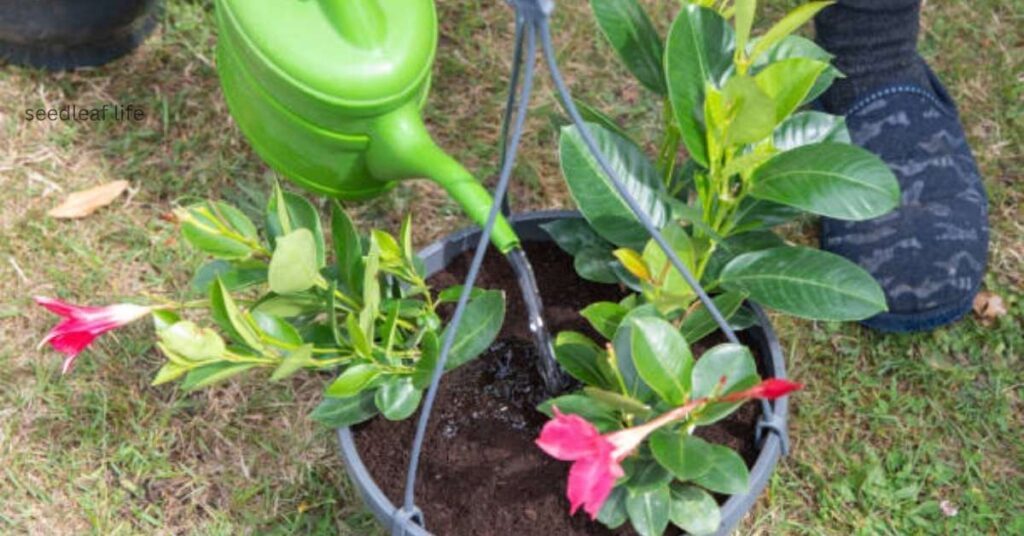
Watering may sound simple, but for Dipladenia planting, getting it right makes all the difference. Too little water and the blooms fade quickly, too much, and the roots can suffer. Finding the balance is the real secret to keeping your plant thriving.
Watering Frequency
Dipladenia doesn’t like soggy feet but also shouldn’t dry out completely.
- In warm weather, water once or twice a week, depending on how fast the soil dries.
- In cooler months, reduce watering to avoid root rot.
- For container plants, check the soil more often, as pots dry out faster than garden beds.
Stick your finger about 2 inches into the soil—if it feels dry, it’s time to water.
Best Time of Day to Water
Morning is the best time to water Dipladenia. Here’s why:
- It allows leaves and soil to dry during the day, reducing disease risk.
- Plants absorb moisture better before the heat of midday sun.
- Evening watering can leave soil damp overnight, which encourages pests and fungal problems.
A quick morning drink sets your Dipladenia up for a healthy, blooming day.
Avoiding Overwatering Problems
Overwatering is the most common mistake in Dipladenia planting. Watch for these warning signs:
- Yellowing leaves.
- Mushy stems.
- Soil that stays wet for days.
To avoid this:
- Always use well-draining soil.
- Ensure pots have drainage holes.
- Water deeply but less frequently, instead of shallow watering every day.
Balanced watering keeps your Dipladenias roots strong and its flowers bright all season long.
Dipladenia Fertilizer Guide
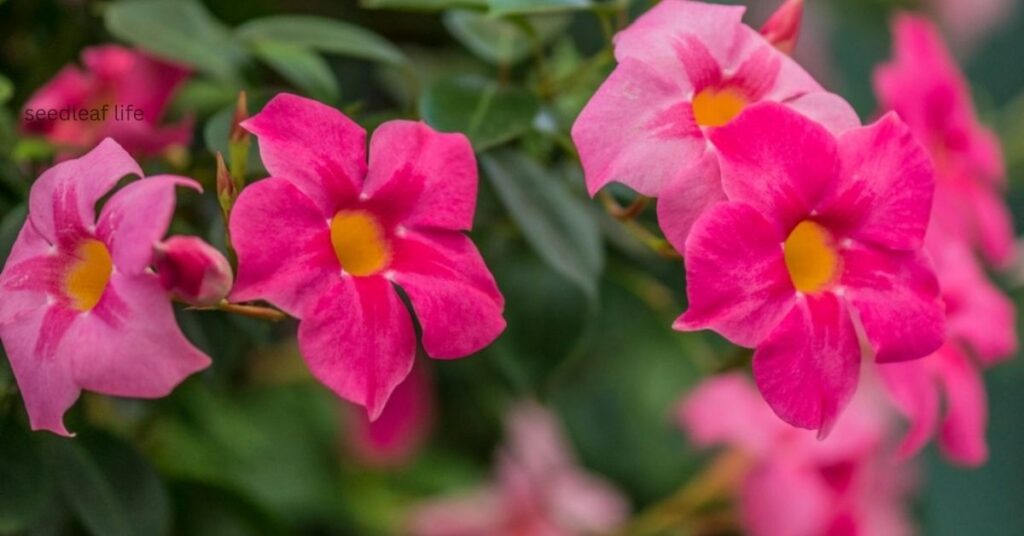
Feeding your plant properly is just as important as watering or sunlight. A well-balanced fertilizer ensures lush foliage, stronger roots, and nonstop flowering throughout the season. Here’s how to give nutrition the right way in your Dipladenia planting journey.
Best Fertilizer Types
Dipladenia thrives on nutrients that support blooming. The best choices include:
- Balanced liquid fertilizers (like 10-10-10 or 20-20-20) for overall growth.
- Bloom boosters with higher phosphorus (middle number) to encourage more flowers.
- Slow-release granules that provide steady nutrition over several weeks.
Liquid feeds act faster, while slow-release types reduce the need for frequent applications.
Fertilizer Schedule for Healthy Blooms
Timing and consistency matter:
- Spring to late summer: Feed every 2–3 weeks with a diluted liquid fertilizer.
- During peak bloom: Use a phosphorus-rich formula to maximize flower production.
- Fall and winter: Reduce or stop fertilizing, since the plant’s growth naturally slows down.
This routine keeps Dipladenia vibrant and blooming over a long season.
Organic vs. Synthetic Fertilizers
Both options work well, but each has its own benefits:
- Organic fertilizers (compost tea, fish emulsion, worm castings) improve soil health and provide gentle, long-lasting nutrients.
- Synthetic fertilizers deliver quick results and precise nutrient ratios, which is great for fast bloom production.
For best results, many gardeners use a combination, organics for soil enrichment and synthetics for targeted feeding during the flowering season.
With the right approach to fertilization, Dipladenia planting becomes more rewarding-your plant will thank you with glossy leaves and a cascade of colorful blossoms.
Dipladenia Maintenance Tips
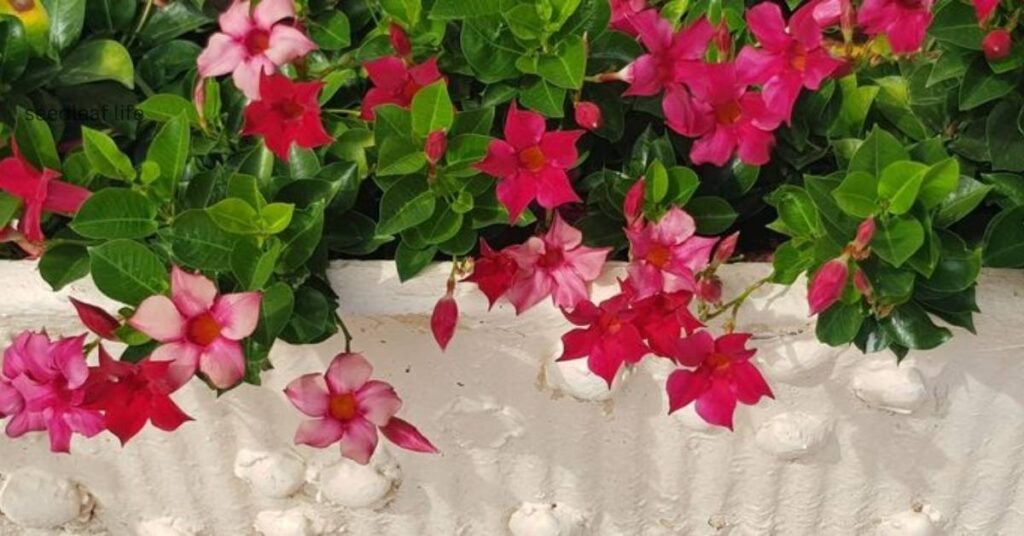
Successful Dipladenia planting doesn’t end with soil and water—it’s the regular care that keeps this tropical beauty at its best. With just a few smart maintenance steps, you can enjoy longer blooms, healthier growth, and a plant that thrives season after season.
Pruning and Shaping the Plant
Pruning keeps Dipladenia compact and bushy rather than leggy.
- Trim back long or tangled stems in early spring.
- Lightly shape the plant after each blooming cycle.
- Always use clean, sharp scissors to avoid damaging the stems.
This not only maintains a neat look but also encourages fresh growth and more flowers.
Deadheading Spent Blooms
Removing faded flowers helps the plant channel energy into new buds instead of seed production.
- Snip off blooms just below the flower head.
- Check weekly during the peak flowering season.
- Combine deadheading with light pruning for best results.
It’s a simple habit that makes a big difference in continuous blooming.
Mulching and Weed Control
A good layer of mulch does double duty:
- Locks in soil moisture.
- Prevents weeds from competing with your plant.
- Keeps the root zone cool in hot climates.
Use organic mulch like shredded bark, straw, or compost for added soil health benefits.
Winter Care and Overwintering
Since Dipladenia is a tropical plant, it’s sensitive to frost.
- Outdoor gardeners: Before the first frost, move containers indoors or cover in-ground plants with frost cloth.
- Indoor care: Place the plant in a sunny window and reduce watering during the cooler months.
- Spring restart: Gradually reintroduce the plant to outdoor conditions once temperatures warm up again.
With proper winter care, your Dipladenia will return stronger and ready for another stunning bloom cycle.
Dipladenia Propagation
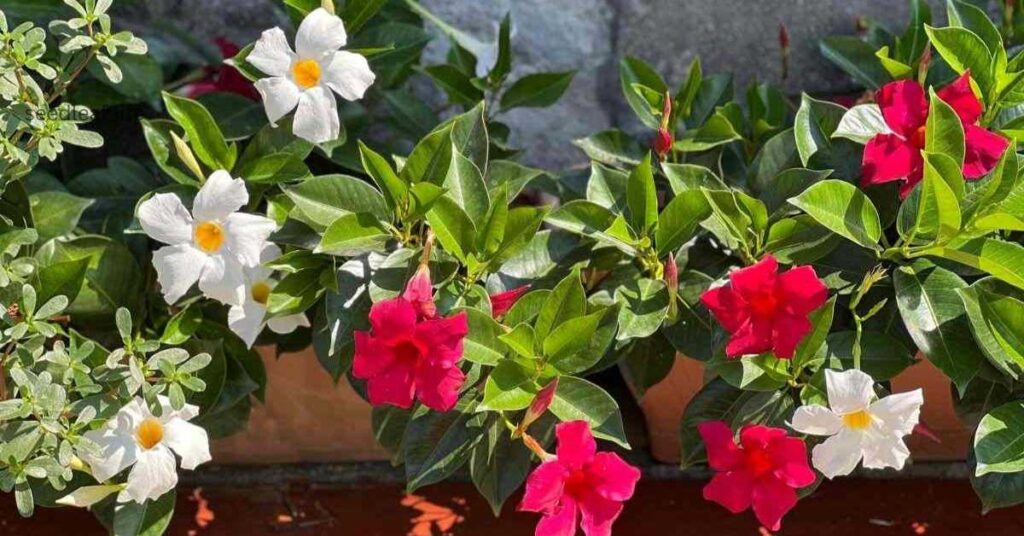
One of the most exciting parts of Dipladenia planting is learning how to multiply your favorite plant. Propagation not only saves money but also lets you share this tropical beauty with friends and family. The most common method is through stem cuttings, which is both fun and rewarding.
Propagation by Stem Cuttings
- Select healthy stems – Choose a non-flowering stem that’s about 4–6 inches long.
- Make a clean cut – Use sterilized scissors to cut just below a leaf node.
- Remove lower leaves – Keep only the top two leaves so the plant focuses energy on root growth.
- Dip in rooting hormone (optional) – This boosts the chances of faster rooting.
- Plant the cutting – Place it in moist potting mix or water (more on this below).
Rooting in Water vs. Soil
- Water method: Place the cutting in a clear jar filled with fresh water. Roots usually appear in 2–4 weeks. Change the water regularly to keep it clean.
- Soil method: Insert the cutting into a pot with well-draining soil. Cover with a plastic bag to create a mini greenhouse effect and maintain humidity.
Both methods work, but soil rooting often results in stronger plants that adapt better when transplanted outdoors.
Tips for Successful Propagation
- Keep the cuttings in a warm, bright location but out of direct sunlight.
- Mist lightly to maintain humidity without making the soil soggy.
- Be patient—roots may take several weeks to form.
- Once the roots are 2–3 inches long, transplant into a larger pot or directly into the garden.
With a little care and patience, propagation can turn one Dipladenia into many, making your Dipladenia planting experience even more rewarding.
Dipladenia Pests and Diseases
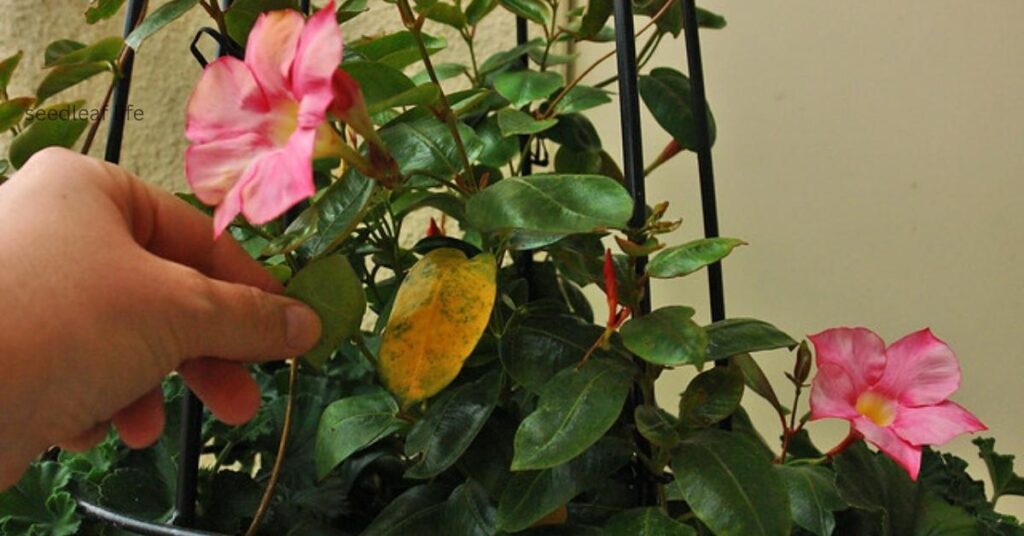
Even with the best care, Dipladenia planting can face occasional challenges from pests and diseases. The good news? Most issues are easy to spot and treat if handled early. Let’s go through the most common ones and how to manage them.
Common Pests (Aphids, Mites, Whiteflies)
- Aphids: Tiny green or black insects that suck plant sap, causing curled leaves and sticky residue.
- Spider Mites: Very small but leave behind fine webbing on the undersides of leaves, leading to yellow spots.
- Whiteflies: Little white, moth-like pests that fly up when the plant is disturbed. They weaken the plant by feeding on sap.
Regularly inspecting leaves, especially the undersides, helps you catch infestations before they spread.
Common Diseases (Root Rot, Leaf Spot, Powdery Mildew)
- Root Rot: Caused by overwatering or poor drainage; roots turn brown and mushy, and the plant wilts.
- Leaf Spot: Dark brown or black spots appear on foliage, often due to fungal infection in humid conditions.
- Powdery Mildew: White, powdery coating on leaves, common in damp, shady environments.
Proper watering practices and good air circulation are key to preventing most of these problems.
Natural and Chemical Solutions
- Natural remedies: Neem oil, insecticidal soap, or a homemade spray of water and mild dish soap can control aphids and mites. Removing heavily infected leaves also helps stop spread.
- Biological control: Introducing ladybugs or predatory mites can naturally reduce harmful insect populations.
- Chemical treatments: If natural options don’t work, use a targeted insecticide or fungicide. Always follow instructions carefully to avoid harming beneficial insects.
With a little attention, you can keep pests and diseases under control, ensuring your Dipladenia planting stays healthy and full of blooms.
Dipladenia Temperature Needs
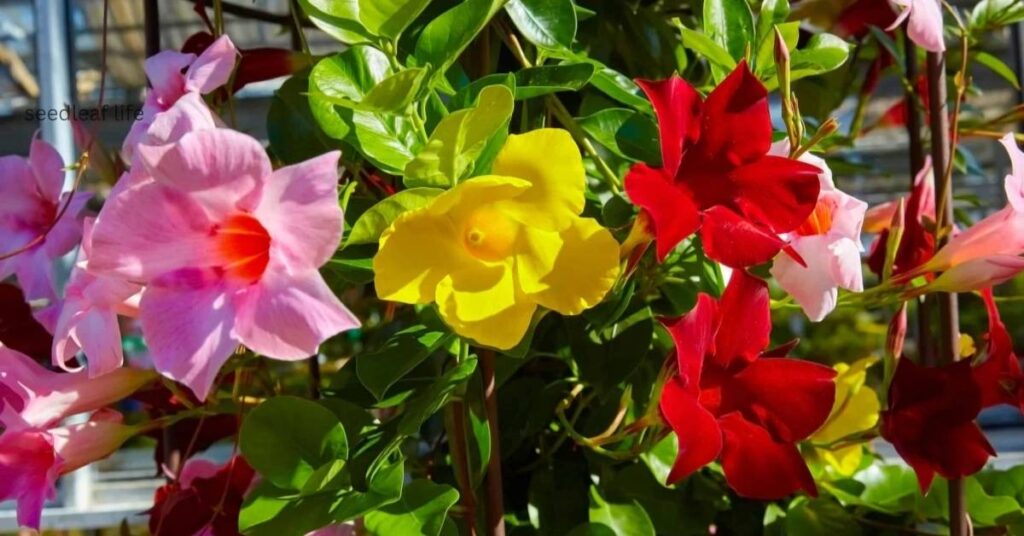
Temperature plays a huge role in successful Dipladenia planting. Since this is a tropical plant, it loves warmth and struggles in the cold. By understanding its ideal range and how to protect it in winter, you can keep your plant thriving year after year.
Ideal Growing Temperature
- Best growth happens between 65–85°F (18–29°C).
- Warm days and mild nights encourage nonstop flowering.
- Humid conditions mimic its natural environment and help prevent stress.
If temperatures stay within this range, Dipladenia will reward you with healthy foliage and vibrant blooms.
Cold Sensitivity and Frost Protection
Dipladenia is not frost-tolerant. Even a light freeze can damage leaves and stems.
- In cooler regions, grow it in containers so you can move it indoors when frost threatens.
- For garden beds, cover with frost cloths or blankets on chilly nights.
- Avoid sudden temperature drops by gradually acclimating the plant when moving it between indoors and outdoors.
Indoor Care During Winter
If you live in a cold climate, bring your plant indoors before nighttime temperatures fall below 55°F (13°C).
- Place it near a south-facing window for maximum light.
- Reduce watering since the plant’s growth naturally slows.
- Keep it away from heating vents or drafty windows to avoid temperature stress.
By protecting it during cold months, your Dipladenia will rest, then bounce back strong and ready to bloom again in spring.
Conclusion
Dipladenia planting is a simple yet rewarding way to add tropical color to any garden or patio. Just remember the basics—plenty of sunlight, well-draining soil, balanced watering, and seasonal care. With a little pruning, feeding, and protection from frost, this plant will bloom beautifully for months.
If you want a low-maintenance flower that brings vibrant charm and long-lasting beauty, Dipladenia is a perfect choice.

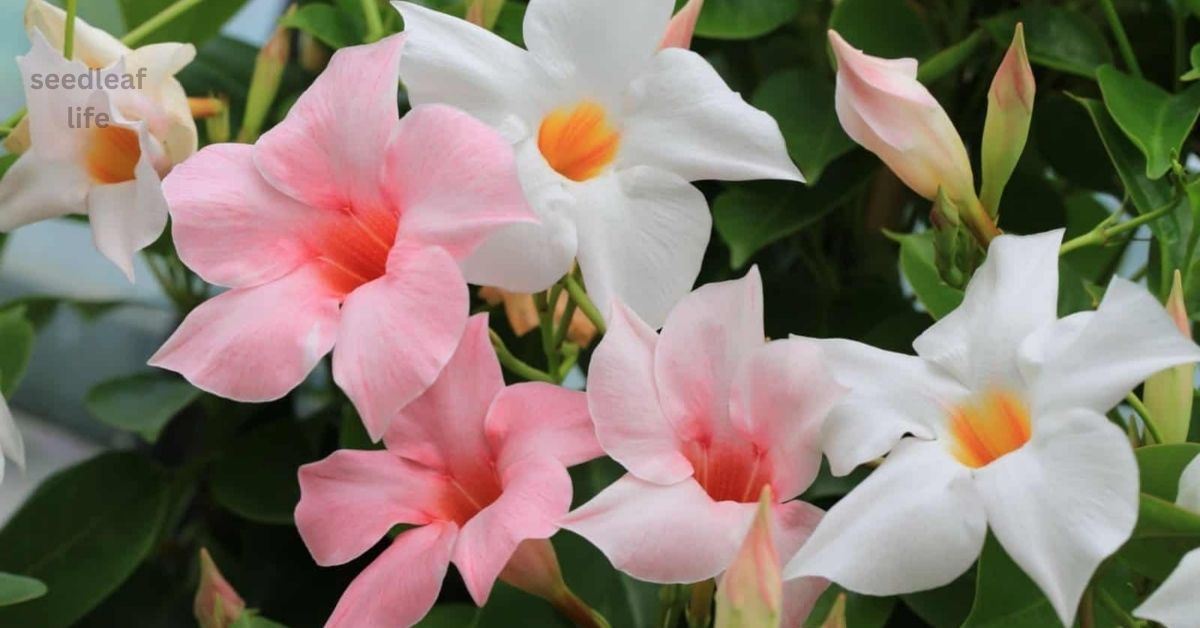
Leave a Reply to Beautiful Yellow Plants to Brighten Up Your Garden Cancel reply